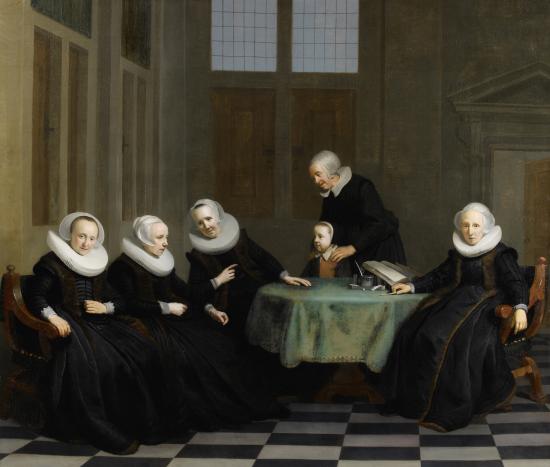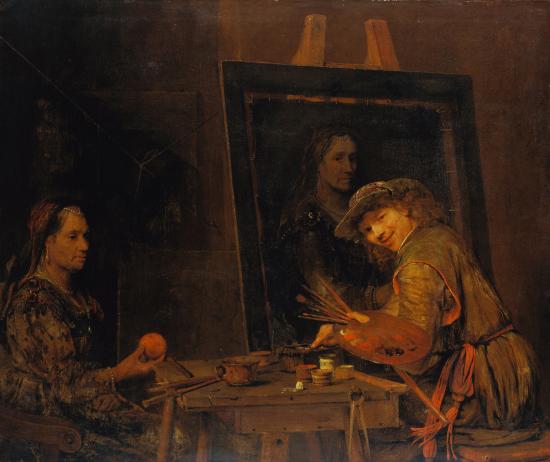PRESS RELEASE
REMBRANDT’S AMSTERDAM
GOLDEN TIMES?
27 NOVEMBER 2024 TO 23 MARCH 2025
Exhibition Annex
Amsterdam – one city with many faces. In the 17th century, Amsterdam was the metropolis in Europe. The economy and trade were booming, the population rapidly increased, and the arts and sciences flourished. An influential civic society shaped the city’s fortunes and glorified itself in splendid group portraits made by the greatest Dutch painters of the age, foremost among them Rembrandt, alongside Jacob Backer, Ferdinand Bol, Govert Flinck, Bartholomeus van der Helst, Nicolaes Eliasz. Pickenoy, and Jan Victors. From 27 November 2024 to 23 March 2025, the Städel Museum, in collaboration with the Amsterdam Museum, showcases portraits from the Rembrandt period in a major exhibition, with the magnificent group portraits of the Amsterdam Museum taking centre stage. These works are rarely lent out, and this is the first large-scale presentation of them in Germany. Around 100 paintings, sculptures and prints and cultural and historical artefacts from other prominent Dutch and international museums will be on view in Frankfurt, including masterpieces from the Rijksmuseum in Amsterdam, the Metropolitan Museum of Art in New York, the Koninklijk Museum van Schone Kunsten in Antwerp and the Muzeum Narodowe in Warsaw. The exhibition will also feature remarkable works by Rembrandt and his contemporaries from the Städel Museum’s own collection.
“Rembrandt’s Amsterdam. Golden Times?” is sponsored by ING Germany, the Städelscher Museums-Verein e. V., the Dagmar-Westberg-Stiftung and the Fontana Stiftung, with additional support from the Ernst von Siemens Kunststiftung.
The exhibition challenges the traditional view of the 17th century as the Netherlands’ ‘Golden Age’. The economic and cultural prosperity of the Rembrandt era was bolstered by the aggressive trade policies of the United Netherlands, which relied on the establishment of colonies in Asia and South America as well as the enslavement and exploitation of people. As wars, poverty and religious and political persecution swept across Europe, migration to the Dutch Republic – particularly Amsterdam – steadily increased. A robust labour market and an unparalleled degree of religious tolerance attracted many in search for a better and freer life, a goal that some, but by no means all, achieved. It was primarily Amsterdam’s urban elite that commissioned lavish portraits of themselves: members of the civic guards and the craft and trade guilds, as well as the governors of the social institutions supported by civic society. While showcasing these prestigious paintings, the exhibition at the Städel Museum also illuminates the experiences of other social groups. Visitors will encounter images and narratives reflecting a pluralistic Amsterdam society, which tell of wealth and poverty, joy and hardship, power and powerlessness.
In the words of Städel Director Philipp Demandt: “With this exhibition, we are bringing Rembrandt’s Amsterdam to the Städel Museum. By taking a critical look at the realities of 17th-century Amsterdam, we engage with the ongoing discourse surrounding the re-evaluation of the Netherlands’ ‘Golden Age’. The masterpieces of Rembrandt and his renowned contemporaries depict a city in flux, undergoing profound economic and social transformations. No other museum in the world houses as many group portraits from this period as the Amsterdam Museum. At the Städel Museum, we are excited to unite these works with other international loans and our own exceptional collection of paintings and prints by Rembrandt, which our museum’s founder already collected with passion. We extend our heartfelt thanks to all the lenders and sponsors who have generously supported our exhibition. This ambitious project would not have been possible without their commitment.”
“Amsterdam – Europe’s vibrant metropolis, a timeless favourite among travellers and a haven of art and culture. This holds true today just as it did during Rembrandt’s era. During the life of the renowned painter, the city’s economy and culture flourished on an unprecedented scale. This exhibition explores both the ‘Golden Age’ and its darker aspects. Following the 2021 Rembrandt exhibition at the Städel Museum that focused on the peerless artist himself, we now invite visitors to immerse themselves in the city where he lived and worked with many other pioneering artists. As ING Germany, we are delighted to support this exhibition, making Dutch art once again accessible to the Städel’s visitors”, says Nick Jue, Chairman of the Board, ING Germany.
As Sylvia von Metzler, Chairwoman of the Board of the Städelscher Museums-Verein e. V., comments about the exhibition: “The exhibition ‘Rembrandt’s Amsterdam’ is the highlight of our anniversary year. For 125 years, we have been supporting the Städel Museum in all its endeavours, and the Städel’s own works by Rembrandt featured in this exhibition reflect our extraordinary commitment. We are thrilled that this great Dutch artist is once again at the centre of a major exhibition, alongside many of his contemporaries. We will experience Rembrandt’s Amsterdam in a new and surprising light.”
Daniel Hoster, Chairman of the Board of the Dagmar-Westberg-Stiftung, points out that “Our founder, Dagmar Westberg, was a devoted patron and friend of the Städel Museum. She had a lifelong passion for the art of the Old Masters, which also informed the donations she made to the museum’s collection. Our support of the exhibition ‘Rembrandt’s Amsterdam’ reflects her desire to share her fascination with Old Master painting with a broad audience and reveal the stories behind the works of art. The Dagmar Westberg Foundation wishes the Städel Museum great success and many interested visitors.”
“The Dutch group portrait emerged primarily in Amsterdam. It is probably the most striking example of Dutch art from Rembrandt’s time. It can be attributed to the unique conditions of Amsterdam, a mercantile city with a distinctly bourgeois and Protestant character. During this time, the city transformed into a booming global trade hub, where the ruling elite celebrated their status and civic commitment through prestigious paintings created by leading artists. While the notion of the 17th century as a ‘Golden Age’ has long been uncritically accepted in the Netherlands—partly due to these artworks—this perspective has begun to erode in recent years. Our exhibition addresses this shift by also highlighting those individuals who were deemed ‘unworthy of portrayal’ at the time and thus left little mark on the tradition of portraiture. The quest to uncover their stories is both overdue and valuable, as it will enhance our understanding of Rembrandt’s Amsterdam,’ explains Jochen Sander, curator of the exhibition, Deputy Director and Head of the collections of Dutch, Flemish and German painting before 1800
Curator: Prof. Dr Jochen Sander (Deputy Director and Head of German, Dutch and Flemish Paintings before 1800, Städel Museum)
Supported by: ING Deutschland, Städelscher Museums-Verein e. V., Fontana Stiftung
With additional support from: Ernst von Siemens Kunststiftung
The detailed press information can be found here.

 29.01.2025: Was bewegt Rineke Dijkstra?
29.01.2025: Was bewegt Rineke Dijkstra?
 17.12.2024: Gastkommentar: Kunst und Zellstrukturen mit Biophysiker Werner Kühlbrandt
17.12.2024: Gastkommentar: Kunst und Zellstrukturen mit Biophysiker Werner Kühlbrandt
 16.12.2024: Rembrandts Amsterdam. Goldene Zeiten? | JETZT IM STÄDEL MUSEUM
16.12.2024: Rembrandts Amsterdam. Goldene Zeiten? | JETZT IM STÄDEL MUSEUM
 26.07.2024: Städel | Frauen. Künstlerinnen zwischen Frankfurt und Paris um 1900
26.07.2024: Städel | Frauen. Künstlerinnen zwischen Frankfurt und Paris um 1900
 14.06.2024: Gastkommentar: Kunst und die innere Uhr mit Chronobiologe Manuel Spitschan
14.06.2024: Gastkommentar: Kunst und die innere Uhr mit Chronobiologe Manuel Spitschan
 31.05.2024: Was bewegt Muntean/Rosenblum?
31.05.2024: Was bewegt Muntean/Rosenblum?
 28.03.2024: KOLLWITZ | STÄDEL MUSEUM
28.03.2024: KOLLWITZ | STÄDEL MUSEUM
 16.02.2024: Gastkommentar: Kunst & Demographischer Wandel mit Wirtschaftswissenschaftler Axel Börsch-Supan
16.02.2024: Gastkommentar: Kunst & Demographischer Wandel mit Wirtschaftswissenschaftler Axel Börsch-Supan
 08.02.2024: Honoré Daumier. Die Sammlung Hellwig | STÄDEL MUSEUM
08.02.2024: Honoré Daumier. Die Sammlung Hellwig | STÄDEL MUSEUM
 26.01.2024: Was bewegt Miron Schmückle?
26.01.2024: Was bewegt Miron Schmückle?



























